Insights from Dikes for Multistage Granitic Magmatism in the Huayangchuan Uranium Polymetallic Deposit, Qinling Orogen
Abstract
:1. Introduction
2. Regional Geology and Deposit Geology
2.1. Regional Geology
2.2. Deposit Geology
3. Sampling and Analytical Methods
3.1. Whole-Rock Major and Trace Element Analyses
3.2. Zircon LA-ICP-MS U–Pb Dating and Trace Element Analyses
3.3. Whole-Rock Sr–Nd Isotope Analyses
3.4. Zircon LA-MC-ICP-MS Hf Isotope Analyses
4. Analytical Results
4.1. Petrography
4.2. Zircon U–Pb Ages and Trace Elemental Compositions
4.2.1. Hornblende-Bearing Granite Porphyry
4.2.2. Medium-Fine-Grained Biotite Granite
4.3. Whole-Rock Major and Trace Element Compositions
4.4. Whole-Rock Sr–Nd Isotope Composition
4.5. Zircon Hf Isotope Composition
5. Discussion
5.1. Multistage Magmatic Activities
5.2. Granite Petrogenesis
5.3. Implications for Tectonic Evolution and Metallogenesis
6. Conclusions
- (1)
- Zircon LA-ICP-MS U–Pb dating for the granitic rocks in the Huayangchuan uranium polymetallic deposit redefined two stages of magmatism.
- (2)
- The hornblende-bearing granite porphyry showed more adakitic affinities. The geochemical features suggest that they were derived from the partial melting of the thickened ancient crust of the Taihua Group.
- (3)
- The medium-fine-grained biotite granites have I-type granite characteristics and were likely sourced from the partial melting of ancient continental crustal rocks.
- (4)
- The granite porphyry responded to the late Indosinian tectonic movement of the Qinling area and was broadly coeval with adjacent carbonatite magmas and stage I U mineralization. The biotite granites are typical representatives of magmatic events during the Yanshanian transition of tectonic regimes and provided heat sources for stage II uranium polymetallic mineralization.
Author Contributions
Funding
Data Availability Statement
Acknowledgments
Conflicts of Interest
References
- IAEA. Geological Classification of Uranium Deposit and Description of Selected Examples; IAEA Tecdoc Series; IAEA Tecdoc 1842; IAEA: Vienna, Austria, 2018. [Google Scholar]
- IAEA. OECD Nuclear Energy Agency Uranium 2018: Resources, Production and Demand (The Red Book); IAEA: Vienna, Austria, 2018. [Google Scholar]
- Dong, Y.P.; Zhang, G.W.; Hauzenberger, C.; Neubauer, F.; Yang, Z.; Liu, X. Palaeozoic tectonics and evolutionary history of the Qinling orogen: Evidence from geochemistry and geochronology of ophiolite and related volcanic rocks. Lithos 2011, 122, 39–56. [Google Scholar] [CrossRef]
- Zhang, G.W.; Meng, Q.R.; Yu, Z.P.; Sun, Y.; Zhou, D.W.; Guo, A.L. Orogenesis and dynamics of Qinling orogen. Sci. China Ser. D 1996, 39, 225–234. [Google Scholar]
- Zhai, M.G. Multi-stage crustal growth and cratonization of the North China Craton. Geosci. Front. 2014, 5, 457–469. [Google Scholar] [CrossRef]
- Chen, Y.J.; Li, N.; Deng, X.H.; Yang, Y.F.; Pirajno, F. Molybdenum Mineralization in Oinling Orogen; Science Press: Beijing, China, 2021. [Google Scholar]
- Xu, C.; Campbell, I.H.; Allen, C.M.; Huang, Z.L.; Qi, L.; Zhang, H.; Zhang, G.S. Flat rare earth element patterns as an indicator of cumulate processes in the Lesser Qinling carbonatites, China. Lithos 2007, 95, 267–278. [Google Scholar] [CrossRef]
- Chen, Y.J.; Pirajno, F.; Qi, J.P. The Shanggong gold deposit, eastern Qinling Orogen, China: Isotope geochemistry and implications for ore genesis. Asian J. Earth Sci. 2008, 33, 252–266. [Google Scholar] [CrossRef]
- Mao, J.W.; Pirajno, F.; Xiang, J.F.; Gao, J.J.; Ye, H.S.; Li, Y.F.; Guo, B.J. Mesozoic molybdenum deposits in the east Qinling-Dabie orogenic belt: Characteristics and tectonic settings. Ore Geol. Rev. 2011, 43, 264–293. [Google Scholar] [CrossRef]
- Deng, X.H.; Chen, Y.J.; Pirajno, F.; Li, N.; Yao, J.M.; Sun, Y.L. The geology and geochronology of the Waifangshan Mo-quartz vein cluster in eastern Qinling, China. Ore Geol. Rev. 2017, 81, 548–564. [Google Scholar] [CrossRef]
- Ying, Y.C.; Chen, W.; Simonetti, A.; Jiang, S.Y.; Zhao, K.D. Significance of hydrothermal reworking for REE mineralization associated with carbonatite: Constraints from in situ trace element and C-Sr isotope study of calcite and apatite from the Miaoya carbonatite complex (China). Geochim. Cosmochim. Acta 2020, 280, 340–359. [Google Scholar] [CrossRef]
- Li, N.; Chen, Y.J.; Santosh, M.; Pirajno, F. Compositional polarity of Triassic granitoids in the Qinling Orogen, China: Implication for termination of the northernmost Paleo-Tethys. Gondwana Res. 2015, 27, 244–257. [Google Scholar] [CrossRef]
- Cai, J.X.; Yu, L.L.; Xu, D.R.; Gao, C.; Chen, G.W.; Yu, D.S.; Jiao, Q.Q.; Ye, T.W.; Zou, S.H.; Li, L.R. Multiple episodes of tectono-thermal disturbances in the Huayangchuan U-Nb-Pb polymetallic deposit in the Xiaoqinling region, central China and their significances on metallogeny. Ore Geol. Rev. 2020, 127, 103755. [Google Scholar] [CrossRef]
- Gao, L.G.; Chen, Y.W.; Bi, X.W.; Gao, J.F.; Chen, W.T.; Dong, S.H.; Luo, J.C.; Hu, R.Z. Genesis of carbonatite and associated U-Nb-REE mineralization atthe Huayangchuan, central China: Insights from mineral paragenesis, chemical and Sr–Nd–C–O isotopic compositons of calcite. Ore Geol. Rev. 2021, 138, 104310. [Google Scholar] [CrossRef]
- Xue, S.; Ling, M.X.; Liu, Y.L.; Kang, Q.Q.; Huang, R.F.; Zhang, Z.K.; Sun, W.D. The formation of the giant the Huayangchuan U-Nb deposit associated with carbonatite in the Qingling Orogenic Belt. Ore Geol. Rev. 2020, 122, 103498. [Google Scholar] [CrossRef]
- Yang, C.S.; Zhao, L.D.; Zheng, H.; Wang, D.Q. The multiple granitic magmatism in the giant the Huayangchuan uranium polymetallic ore district: Implications for tectonic evolution of the southern margin of North China Craton in the Qinling Orogen. Ore Geol. Rev. 2019, 112, 103055. [Google Scholar] [CrossRef]
- Zheng, H.; Chen, H.; Wu, D.; Jiang, H.J.; Gao, C.; Kang, Q.Q.; Yang, C.S.; Wang, D.Q.; Lai, C.K. Genesis of the supergiant Huayangchuan carbonatite-hosted uranium-polymetallic deposit in the Qinling Orogen, Central China. Gondwana Res. 2020, 86, 250–265. [Google Scholar] [CrossRef]
- Huang, H.; Pan, J.Y.; Zhong, F.J.; Yan, J.; Hong, B.Y.; Kang, Q.Q.; Wan, J.J. LA-ICP-MS in-situ U–Pb dating and genesis of the early cretaceous uraninite in the Huayangchuan U-polymetallic deposit, Shaanxi Province, China. Acta Mineral. Sin. 2020, 40, 569–583. [Google Scholar]
- Bonnetti, C.; Riegler, T.; Liu, X.D.; Cuney, M. Granite-related high-temperature hydrothermal uranium mineralisation: Evidence from the alteration fngerprint associated with an early Yanshanian magmatic event in the Nanling belt, SE China. Miner. Deposita 2023, 58, 427–460. [Google Scholar] [CrossRef]
- Zhong, F.J.; Xia, F.; Wang, L.; Liu, G.Q.; Pan, J.Y.; Liu, Y.; Li, Z.P. Geochronology and geochemistry of dolerite in the Lujing uranium ore field of central Zhuguangshan complex, and its relationship with uranium mineralization. Acta Geol. Sin. 2023, 97, 2593–2608. (In Chinese) [Google Scholar]
- Hui, X.C.; Li, Z.Y.; Feng, Z.S.; Cheng, D.J. Research on the occurrence state of U in the Huayangchuan U-polymetal deposit, Shanxi Province. Acta Mineral. Sin. 2014, 34, 573–580. (In Chinese) [Google Scholar]
- Li, P.T.; Li, Y.J.; Gu, P.Y.; He, S.P.; Zhuang, Y.J.; Chen, R.M. Paleoproterozoic U-mineralization in Huayangchuan deposit, Xiaoqinling area: Evidence from the U–rich granitic pegmatite. Minerals 2023, 13, 936. [Google Scholar] [CrossRef]
- Ren, Y.S.; Yang, X.Y.; Wang, G.J. Study on the complex magmatic and hydrothermal metallogenic processes in the giant Huayangchuan uranium (U)-polymetallic ore district: Constraints from geochemical and geochronological evidences. Ore Geol. Rev. 2023, 163, 105724. [Google Scholar] [CrossRef]
- Meng, Q.F.; Ma, G.Q.; Wang, T.H.; Xiong, S.Q. The Efficient 3D gravity focusing density inversion based on preconditioned JFNK method under undulating terrain: A case study from Huayangchuan, Shaanxi Province, China. Minerals 2020, 10, 741. [Google Scholar] [CrossRef]
- Hu, J.; Jiang, S.Y.; Zhao, H.X.; Shao, Y.; Zhang, Z.Z.; Xiao, E.; Wang, Y.F.; Dai, B.Z.; Li, H.Y. Geochemistry and petrogenesis of the Huashan granites and their implications for the Mesozoic tectonic settings in the Xiaoqinling gold mineralization belt, NW China. Asian J. Earth Sci. 2012, 56, 276–289. [Google Scholar] [CrossRef]
- Zheng, H.; Chen, H.Y.; Li, D.F.; Wu, C.; Chen, X.; Lai, C.K. Timing of carbonatite-hosted U-polymetallic mineralization in the supergiant the Huayangchuan deposit, Qinling Orogen: Constraints from titanite U–Pb and molybdenite Re-Os dating. Geosci. Front. 2020, 11, 1581–1592. [Google Scholar] [CrossRef]
- Dong, Y.P.; Yang, Z.; Liu, X.M.; Sun, S.S.; Li, W.; Cheng, B.; Zhang, F.F.; Zhang, X.N.; He, D.F.; Zhang, G.W. Mesozoic intracontinental orogeny in the Qinling Mountains, central China. Gondwana Res. 2016, 30, 144–158. [Google Scholar] [CrossRef]
- Zhao, G.C.; Wilde, S.A.; Cawood, P.A.; Sun, M. Archean Blocks and their boundaries in the North China Craton: Lithological, geochemical, structural and P-T path constraints and tectonic evolution. Precambrian Res. 2001, 107, 45–73. [Google Scholar] [CrossRef]
- Huang, H.; Pan, J.Y.; Hong, B.Y.; Kang, Q.Q.; Zhong, F.J. EPMA chemical U-Th-Pb dating of uraninite in the Huayangchuan U-polymetallic deposit of Shaanxi Province and its geological significance. Miner. Deposits 2020, 39, 351–368. (In Chinese) [Google Scholar]
- Bai, T.; Chen, W.; Jiang, S.Y. Evolution of the carbonatite Mo-HREE deposits in the Lesser Qinling Orogen: Insights from in situ geochemical investigation of calcite and sulfate. Ore Geol. Rev. 2019, 113, 103069. [Google Scholar] [CrossRef]
- Li, N.; Pirajno, F. Early Mesozoic Mo mineralization in the Qinling Orogen: An overview. Ore Geol. Rev. 2017, 81, 431–450. [Google Scholar] [CrossRef]
- Liu, J.C.; Wang, Y.T.; Mao, J.W.; Jian, W.; Huang, S.K.; Hu, Q.Q.; Wei, R.; Hao, J.L. Precise ages for lode gold mineralization in the Xiaoqinling goldfield, southern margin of the north China craton: New constraints from in-situ U–Pb dating of hydrothermal monazite and rutile. Econ. Geol. 2021, 116, 773–786. [Google Scholar] [CrossRef]
- Mao, J.W.; Goldfarb, R.J.; Zhang, Z.W.; Xu, W.Y.; Qiu, Y.M.; Deng, J. Gold deposits in the Xiaoqinling-Xiong’ershan region, Central China. Miner. Deposita 2002, 37, 306–325. [Google Scholar] [CrossRef]
- Chen, Y.J.; Wang, P.; Li, N.; Yang, Y.F.; Pirajno, F. The collision-type porphyry Mo deposits in Dabie Shan, China. Ore Geol. Rev. 2017, 81, 405–430. [Google Scholar] [CrossRef]
- Ding, L.X.; Ma, C.Q.; Li, J.W.; Paul, T.R.; Deng, X.D.; Zhang, C.; Xu, W.C. Timing and genesis of the adakitic and shoshonitic intrusions in the Laoniushan complex, southern margin of the North China Craton: Implications for post-collisional magmatism associated with the Qinling Orogen. Lithos 2011, 126, 212–232. [Google Scholar] [CrossRef]
- Gao, X.Y.; Zhao, T.P.; Chen, W.T. Petrogenesis of the early Cretaceous Funiushan granites on the southern margin of the North China Craton: Implications for the Mesozoic geological evolution. Asian J. Earth Sci. 2014, 94, 28–44. [Google Scholar] [CrossRef]
- Wiedenbeck, M.; Alle, P.; Corfu, F.; Griffin, W.L.; Meier, M.; Oberli, F.; Von Quadt, A.; Roddick, J.C.; Spiegel, W. Three natural zircon standards for U-Th-Pb, Lu-Hf, trace element and REE analyses. Geostand. Geoanal. Res. 1995, 19, 1–23. [Google Scholar] [CrossRef]
- Sláma, J.; Košler, J.; Condon, D.J.; Crowley, J.L.; Gerdes, A.; Hanchar, J.M.; Horstwood, M.S.A.; Morris, G.A.; Nasdala, L.; Norberg, N.; et al. Plešovice zircon-A new natural reference material for U–Pb and Hf isotopic microanalysis. Chem. Geol. 2008, 249, 1–35. [Google Scholar] [CrossRef]
- Liu, Y.S.; Hu, Z.C.; Gao, S.; Günther, D.; Xu, J.; Gao, C.G.; Chen, H.H. In situ analysis of major and trace elements of anhydrous minerals by LA-ICP-MS without applying an internal standard. Chem. Geol. 2008, 257, 34–43. [Google Scholar] [CrossRef]
- Ludwig, K.R. User’s Manual for Isoplot 3.00: A Geochronogical Chronological Toolkit for Microsoft Excel; Geochronology Center: Berkeley, CA, USA, 2003. [Google Scholar]
- Liu, H.Y.; Montaser, A.; Dolan, S.P.; Schwartz, R.S. Evaluation of a low sample consumption, high-efficiency nebulizer for elemental analysis of biological samples using inductively coupled plasma mass spectrometry. J. Anal. At. Spectrom. 1996, 11, 307–311. [Google Scholar] [CrossRef]
- Liang, X.R.; Wei, G.J.; Li, X.H.; Liu, Y. Precise measurement of 143Nd/144Nd and Sm/Nd ratios using multiple–collectors inductively couple plasma–mass spectrometer (MC–ICP–MS). Geochimica 2003, 32, 91–96. (In Chinese) [Google Scholar]
- Lin, J.; Liu, Y.S.; Yang, Y.H.; Hu, Z.C. Calibration and correction of LA-ICP-MS and LA-MC-ICP-MS analyses for element contents and isotopic ratios. Solid Earth Sci. 2016, 1, 5–27. [Google Scholar] [CrossRef]
- Zhang, W.; Hu, Z.C. Estimation of isotopic reference values for pure materials and geological reference materials. At. Spectrosc. 2020, 41, 93–102. [Google Scholar] [CrossRef]
- Li, C.F.; Li, X.H.; Li, Q.L.; Guo, J.H.; Yang, Y.H. Rapid and precise determination of Sr and Nd isotopic ratios in geological samples from the same filament loading by thermal ionization mass spectrometry employing a single-step separation scheme. Anal. Chim. Acta 2012, 727, 54–60. [Google Scholar] [CrossRef] [PubMed]
- Zhang, L.; Ren, Z.Y.; Nichols, A.R.L.; Zhang, Y.H.; Zhang, Y.; Qian, S.P.; Liu, J.Q. Lead isotope analysis of melt inclusions by LA–MC–ICP–MS. J. Anal. At. Spectrom. 2014, 29, 1393–1405. [Google Scholar] [CrossRef]
- Segal, I.; Halicz, L.; Platzner, I.T. Accurate isotope ratio measurements of ytterbium by multiple collection inductively coupled plasma mass spectrometry applying erbium and hafnium in an improved double external normalization procedure. J. Anal. At. Spectrom. 2003, 18, 1217–1223. [Google Scholar] [CrossRef]
- Wu, F.Y.; Yang, Y.H.; Xie, L.W.; Yang, J.H.; Xu, P. Hf isotopic compositions of the standard zircons and baddeleyites used in U–Pb geochronology. Chem. Geol. 2006, 234, 105–126. [Google Scholar] [CrossRef]
- Zhang, L.; Ren, Z.Y.; Xia, X.P.; Li, J.; Zhang, Z.F. IsotopeMaker: A Matlab program for isotopic data reduction. Int. J. Mass Spectrom. 2015, 392, 118–124. [Google Scholar] [CrossRef]
- Wu, Y.B.; Zheng, Y.F. Tectonic evolution of a composite collision orogen: An overview on the Qinling-Tongbai-Hong’an-Dabie-Sulu orogenic belt in central China. Gondwana Res. 2013, 23, 1402–1428. [Google Scholar] [CrossRef]
- Hoskin, P.W.O.; Black, L.P. Metamorphic zircon formation by solid-state recrystallization of protolith igneous zircon. J. Metamorph. Geol. 2000, 18, 423–439. [Google Scholar] [CrossRef]
- Middlemost, E.A.K. Naming materials in the magma/igneous rock system. Earth Planet. Sci. Lett. 1994, 67, 137–150. [Google Scholar] [CrossRef]
- Peccerillo, A.; Taylor, A.R. Geochemistry of Eocene calc–alkaline volcanic rocks from the Kastamonu area, Northern Turkey. Contrib. Mineral. Petrol. 1976, 58, 63–81. [Google Scholar] [CrossRef]
- Maniar, P.D.; Piccoli, P.M. Tectonic discrimination of granitoids. Geol. Soc. Am. Bull. 1989, 101, 635–643. [Google Scholar] [CrossRef]
- McDonough, W.F.; Sun, S.S. The composition of the earth. Chem. Geol. 1995, 120, 223–253. [Google Scholar] [CrossRef]
- Jiao, J.G.; Tang, Z.L.; Qian, Z.Z.; Yuan, H.C.; Yan, H.Q.; Sun, T.; Xu, G.; Li, X.D. Metallogenic mechanism, magma source and zircon U-Pb age of Jinduicheng granitic porphyry, East Qinling. J. China Univ. Geosci. 2010, 35, 1011–1022. [Google Scholar]
- Mao, J.W.; Xie, G.Q.; Zhang, Z.H.; Li, X.F.; Wang, Y.T.; Zhang, C.Q.; Li, Y.F. Mesozoic large-scale metallogenic pulses in North China and corresponding geodynamic settings. Acta Petrol. Sin. 2005, 21, 169–188. (In Chinese) [Google Scholar]
- Zhao, H.J.; Mao, J.W.; Ye, H.S.; Hou, K.J.; Liang, H.S. Chronology and petrogenesis of Shijiawan granite porphyry in Shannxi Province: Constrains from zircon U–Pb geochronology and Hf isotopic compositions. Miner. Depos. 2010, 29, 143–157. (In Chinese) [Google Scholar]
- Zindler, A.; Hart, S.R. Chemical geodynamics. Ann. Rev. Earth Planet. Sci. Lett. 1986, 14, 493–571. [Google Scholar] [CrossRef]
- Zhao, H.X.; Jiang, S.Y.; Frimmel, H.E.; Dai, B.Z.; Ma, L. Geochemistry, geochronology and Sr–Nd–Hf isotopes of two Mesozoic granitoids in the Xiaoqinling gold district: Implication for large-scale lithospheric thinning in the North China Craton. Chem. Geol. 2012, 294, 173–189. [Google Scholar] [CrossRef]
- Hu, H.Z.; Li, N.; Deng, X.H.; Chen, Y.J.; Li, Y. Indosinian Mo mineralization in the Qinling area and prospecting potential. Geol. China 2013, 40, 549–565. (In Chinese) [Google Scholar]
- Deng, X.Q.; Peng, T.P.; Zhao, T.P. Geochronology and geochemistry of the Late Paleoproterozoic aluminous A-type granite in the Xiaoqinling area along the southern margin of the North China Craton: Petrogenesis and tectonic implications. Precambrian Res. 2016, 285, 127–146. [Google Scholar] [CrossRef]
- Wang, J.Y.; Li, Z.D.; Zhang, Q.; Li, C.; Xie, Y.; Li, G.Y.; Zeng, W.; Ding, N. Metallogenic epoch of thecarbonatite-type Mo-U polymetallic deposit in east Qinling: Evidence from the monazite LA-ICP-MS U–Pb and molybdenite ReOs isotopic dating. Acta Geol. Sin. 2020, 94, 2946–2964. [Google Scholar]
- Du, Z.W.; Ye, H.S.; Mao, J.W.; Meng, F.; Cao, J.; Wang, P.; Wei, Z.; Ding, J.H. Molybdenite Re-Os gochronology and isotope geochemical characteristics of Xigou molybdenum deposit in Shaanxi Province and its geological significance. Miner. Depos. 2020, 39, 728–744. (In Chinese) [Google Scholar]
- Zhu, L.M.; Zhang, G.W.; Li, B.; Guo, B. Main geological events, genetic types of metallic deposits and their geodynamical setting in the Qinling Orogenic Belt. Bull. Mineral. Petrol. Geochem. 2008, 27, 384–390. (In Chinese) [Google Scholar]
- Defant, M.J.; Drummond, M.S. Derivation of some modern arc magmas by melting of young subducted lithosphere. Nature 1990, 347, 662–665. [Google Scholar] [CrossRef]
- Moyen, J.F.; Martin, H.; Jayananda, M. Multi-element geochemical modelling of crust-mantle interactions during late-Archaean crustal growth: The Closepet granite (South India). Precambrian Res. 2001, 112, 87–105. [Google Scholar] [CrossRef]
- Martin, H.; Smithies, R.H.; Rapp, R.; Moyen, J.F.; Champion, D. An overview of adakite, tonalite-trondhjemite-granodiorite (TTG), and sanukitoid: Relationships and some implications for crustal evolution. Lithos 2005, 79, 1–24. [Google Scholar] [CrossRef]
- Ge, X.Y.; Li, X.H.; Chen, Z.G.; Li, W.P. Geochemistry and petrogenesis of Jurassic high Sr/low Y granitoids in eastern China: Constrains on crustal thickness. Chin. Sci. Bull. 2002, 47, 962–968. [Google Scholar] [CrossRef]
- Li, N.; Chen, Y.J.; Zhang, H.; Zhao, T.; Ni, Z. Molybdenum deposits in East Qinling. Earth Sci. Front. 2007, 14, 186–198. [Google Scholar]
- Dong, Y.P.; Santosh, M. Tectonic architecture and multiple orogeny of the Qinling Orogenic Belt, Central China. Gondwana Res. 2016, 29, 1–40. [Google Scholar] [CrossRef]
- Zhou, H.W.; Li, X.H.; Zhong, Z.Q.; Liu, Y.; Xu, Q.D. Geochemistry of amphibolites within the Taihua complex from the Xiaoqinling area, western Henan and its tectonic implication. Geochemica 1997, 26, 87–100. [Google Scholar]
- Martin, H. Adakitic magmas: Modern analogues of Archaean granitoids. Lithos 1999, 46, 411–429. [Google Scholar] [CrossRef]
- Castillo, P.R.; Janney, P.E.; Solidum, R.U. Petrology and geochemistry of Camiguin Island, southern Philippines: Insights to the source of adakites and other lavas in a complex arc setting. Contrib. Mineral. Petrol. 1999, 134, 33–51. [Google Scholar] [CrossRef]
- Gao, S.; Rudnick, R.L.; Yuan, H.L.; Liu, X.M.; Liu, Y.S.; Xu, W.L.; Ling, W.L.; Ayers, J.; Wang, X.C.; Wang, Q.H. Recycling lower continental crust in the North China Craton. Nature 2004, 432, 892–897. [Google Scholar] [CrossRef] [PubMed]
- Xu, H.J.; Ma, C.Q.; Ye, K. Early Cretaceous granitoids and their implications for the collapse of the Dabie orogen, eastern China: SHRIMP zircon U–Pb dating and geochemistry. Chem. Geol. 2007, 240, 238–259. [Google Scholar] [CrossRef]
- Chapman, J.B.; Ducea, M.N.; DeCelles, P.G.; Profeta, L. Tracking changes in crustal thickness during orogenic evolution with Sr/Y: An example from the North American Cordillera. Geology 2015, 43, 919–922. [Google Scholar] [CrossRef]
- Arth, J.G. Behaviour of trace elements during magmatic processes: A summary of theoretical models and their applications. J. Res. US Geol. Surv. 1976, 4, 41–47. [Google Scholar]
- Diwu, C.R.; Sun, Y.; Lin, C.L.; Liu, X.M.; Wang, H.L. Zircon U–Pb ages and Hf isotopes and their geological significanceof Yiyang TTG gneisses from Henan province, China. Acta Petrol. Sin. 2007, 23, 253–262. [Google Scholar]
- Plank, T.; Langmuir, C.H. The chemical composition of subducting sediment and its consequences for the crust and mantle. Chem. Geol. 1998, 145, 325–394. [Google Scholar] [CrossRef]
- Rickwood, P.C. Boundary lines within petrologic diagrams which use oxides of major and minor elements. Lithos 1989, 22, 247–263. [Google Scholar] [CrossRef]
- Chappell, B.W.; White, A.J.R. Two contrasting granite types: 25 years later. Aust. J. Earth Sci. 2001, 48, 489–499. [Google Scholar] [CrossRef]
- Chappell, B.W. Aluminium saturation in I- and S-type granites and the characterization of fractionated haplogranites. Lithos 1999, 46, 535–551. [Google Scholar] [CrossRef]
- Clemens, J.D. S-type granitic magmas-petrogenetic issues, models and evidence. Earth-Sci. Rev. 2003, 61, 1–18. [Google Scholar] [CrossRef]
- Eby, G.N. Chemical subdivision of the A-type granitoids: Petrogenetic and tectonic implications. Geology 1992, 20, 641–644. [Google Scholar] [CrossRef]
- Taylor, S.R.; Mclennan, S.M. The Continental crust: Its composition and evolution. J. Geol. 1985, 94, 196–197. [Google Scholar]
- Green, T.H. Significance of Nb/Ta as an indicator of geochemical processes in the crust-mantle system. Chem. Geol. 1995, 120, 347–359. [Google Scholar] [CrossRef]
- Rapp, R.P.; Watson, E.B.; Miller, C.F. Partial melting of amphibolite/eclogite and the origin of Archean trondhjemites and tonalites. Precambrian Res. 1991, 51, 1–25. [Google Scholar] [CrossRef]
- Pearce, J.A.; Harris, N.B.W.; Tindle, A.G. Trace element discrimination diagrams for the tectonic interpretation of granitic rocks. J. Petrol. 1984, 25, 956–983. [Google Scholar] [CrossRef]
- Huang, H.; Wang, K.X.; Cuney, M.; Pan, J.Y.; Bonnetti, C.; Liu, X.D.; Zhong, F.J. Mesozoic magmatic and hydrothermal uranium mineralization in the Huayangchuan carbonatite-hosted U-Nb-polymetallic deposit, North Qinling Orogen (Central China): Evidence from uraninite chemical and isotopic compositions. Ore Geol. Rev. 2022, 146, 104958. [Google Scholar] [CrossRef]
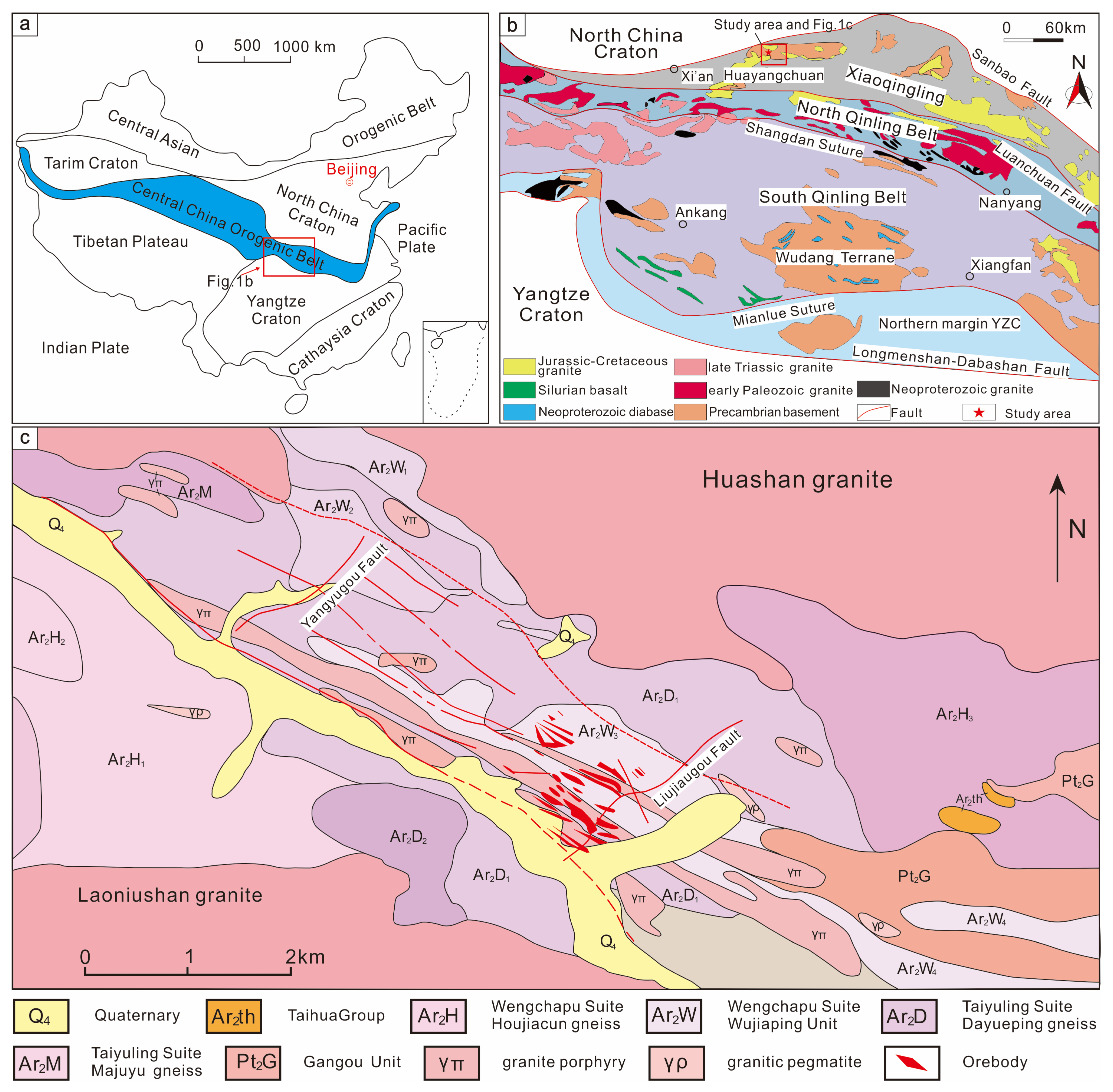
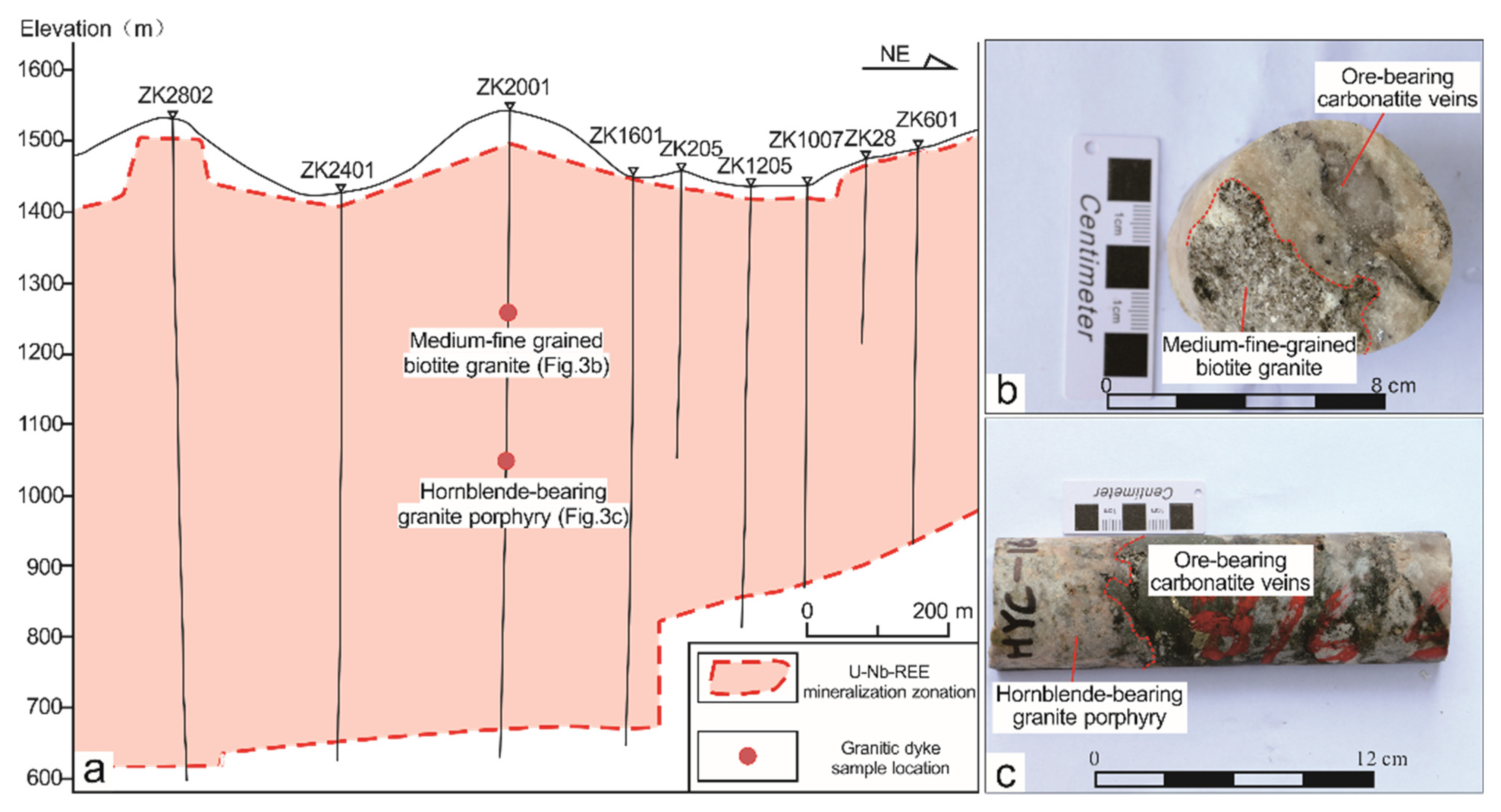


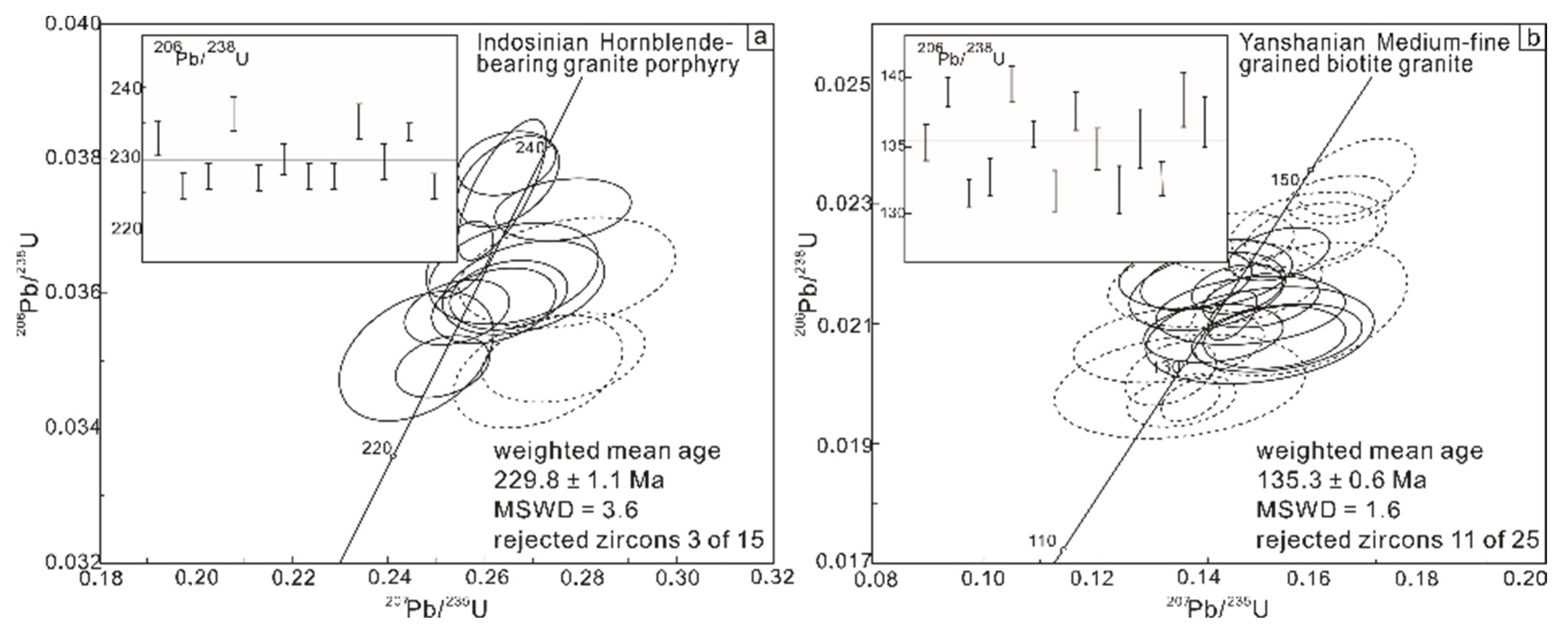
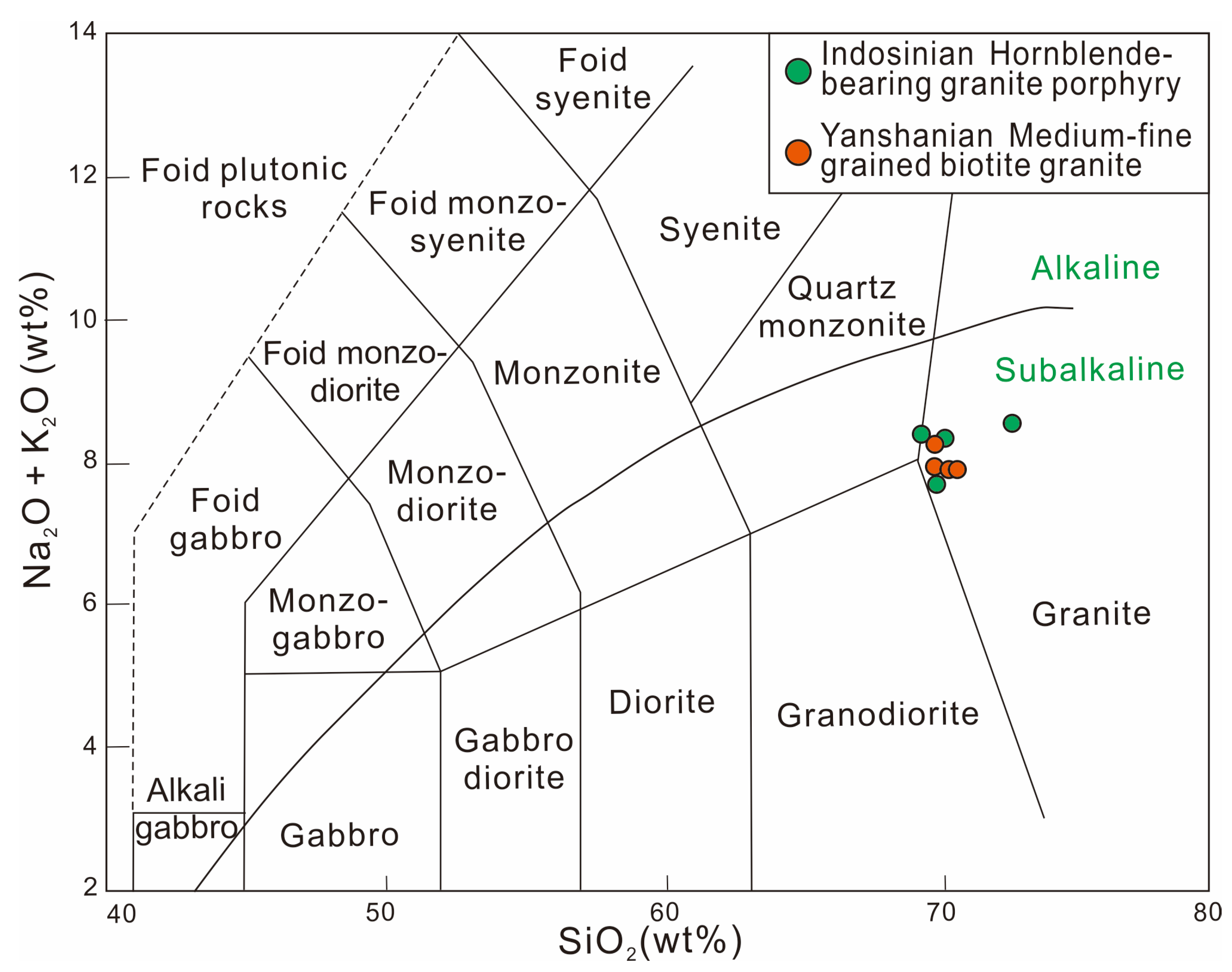
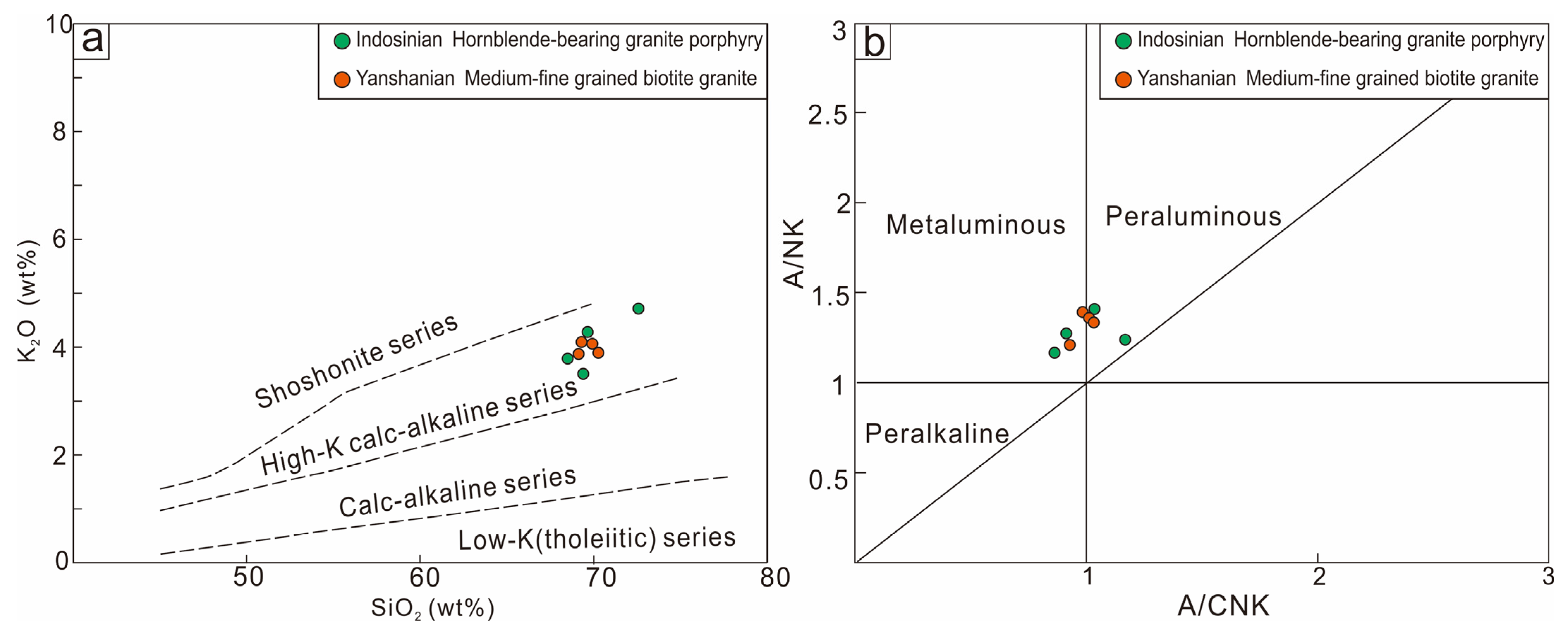
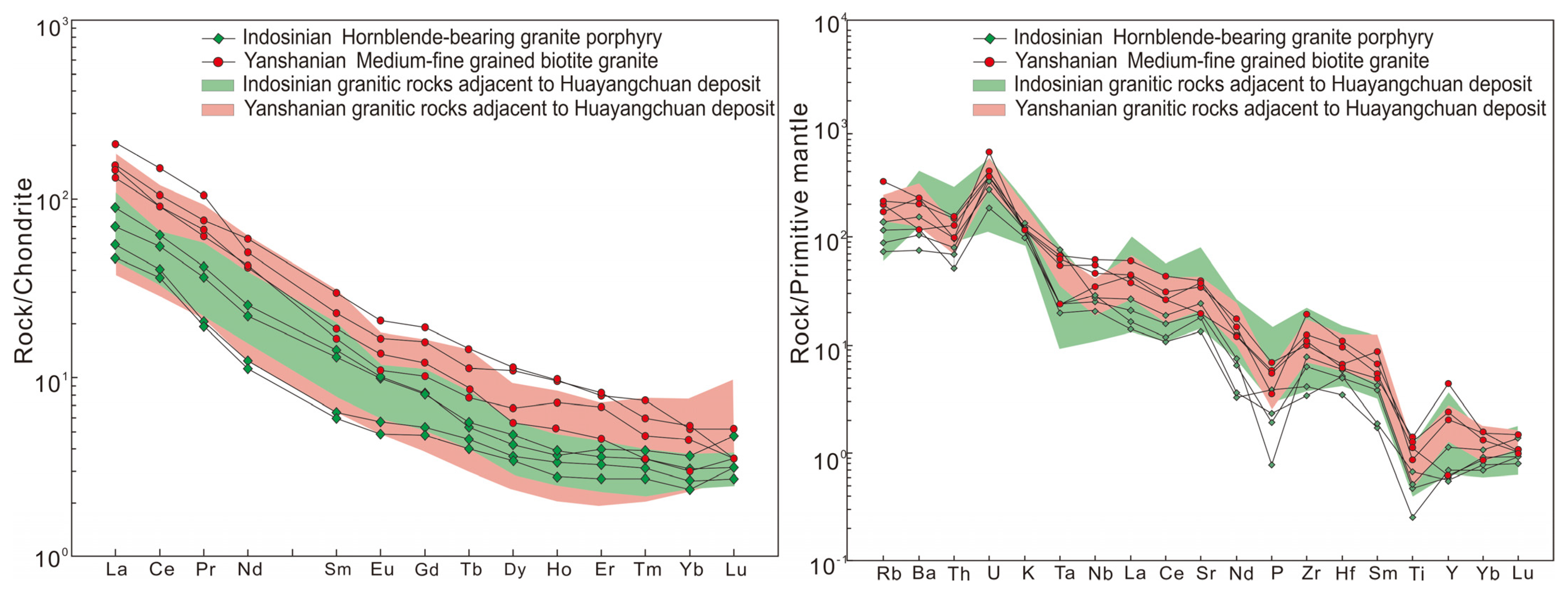

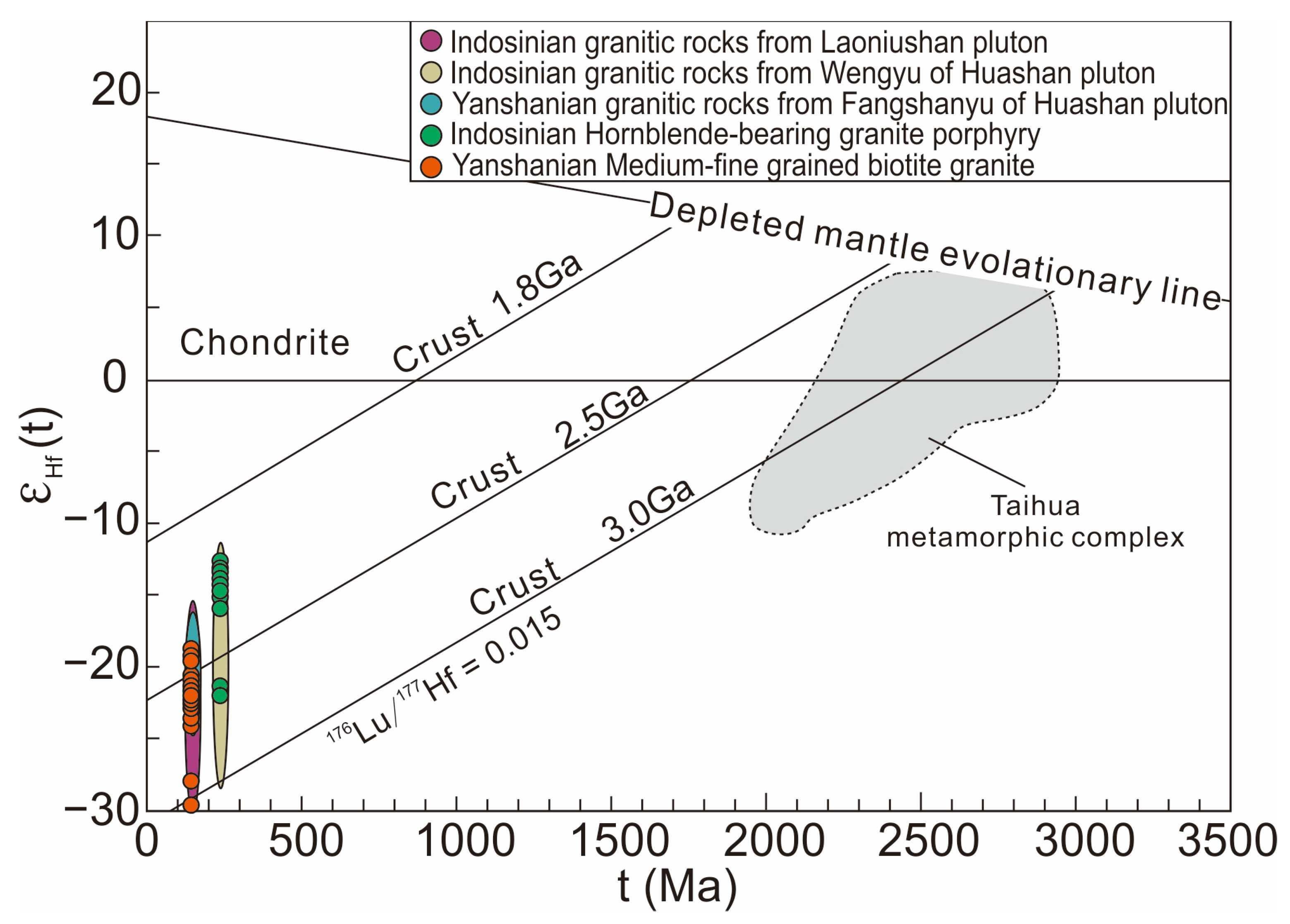
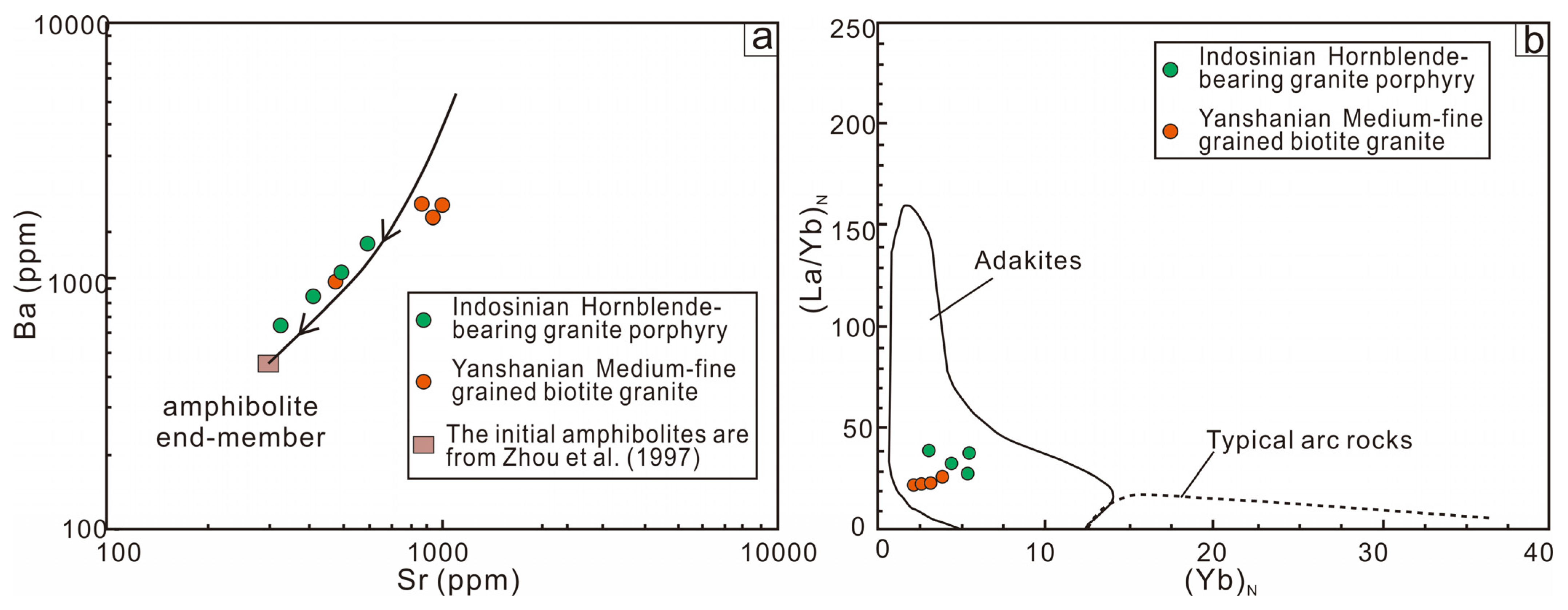

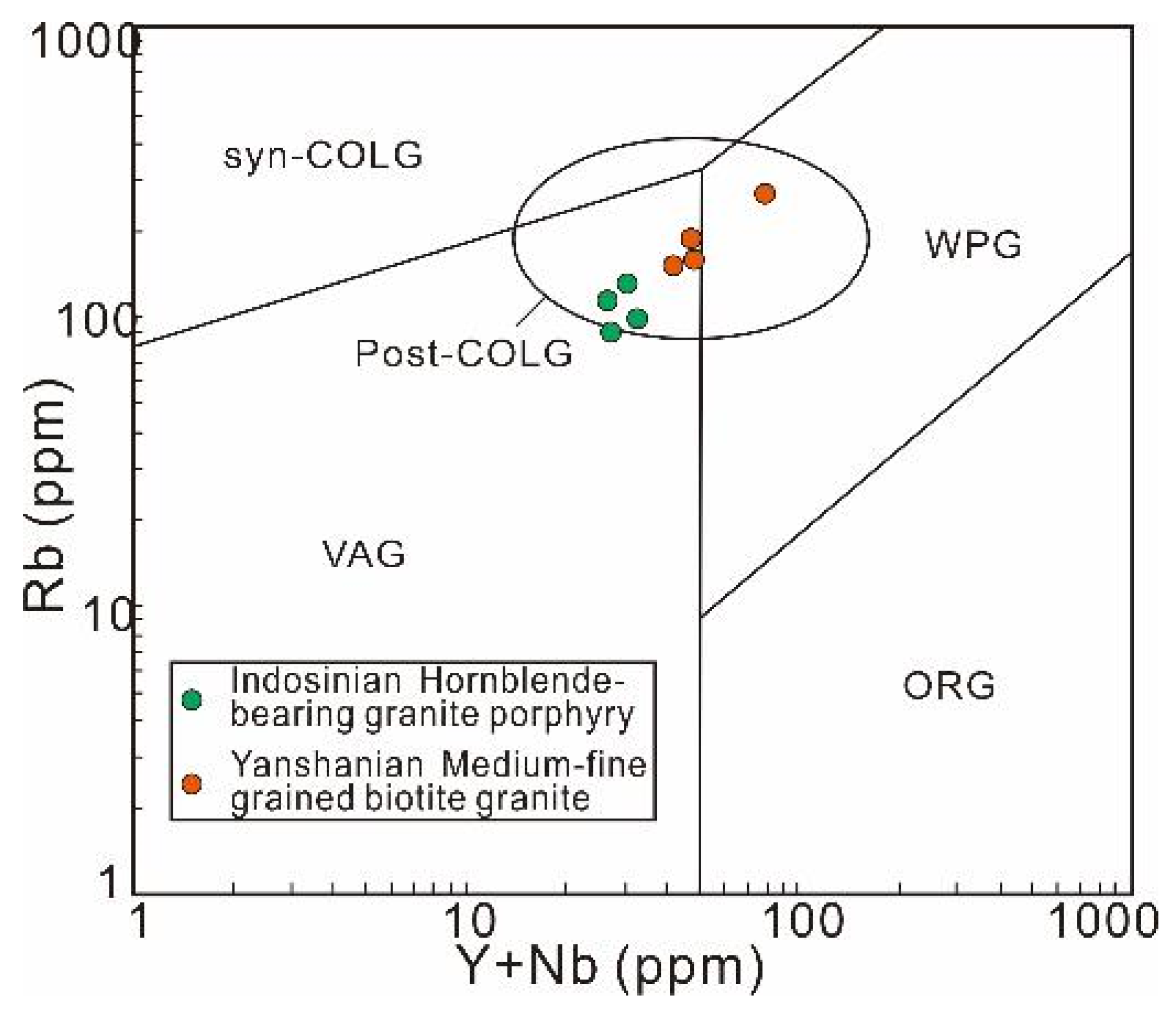
| Test Spot | Th | U | Th/U | 207Pb/206Pb | 207Pb/235U | 206Pb/238U | 207Pb/206Pb | 207Pb/235U | 206Pb/238U | Conc. | Use or Not during Weighted Mean Age Calculation | ||||||
|---|---|---|---|---|---|---|---|---|---|---|---|---|---|---|---|---|---|
| (×10−6) | Ratio | 1σ | Ratio | 1σ | Ratio | 1σ | Age (Ma) | 1σ | Age (Ma) | 1σ | Age (Ma) | 1σ | |||||
| Hornblende-bearing granite porphyry | |||||||||||||||||
| 19MY01-1 | 384 | 696 | 0.55 | 0.05065 | 0.00121 | 0.25999 | 0.00633 | 0.03739 | 0.00030 | 225 | 92 | 236 | 8 | 238 | 2 | 97% | not |
| 19MY01-2 | 47.5 | 138 | 0.34 | 0.04854 | 0.00161 | 0.24411 | 0.00764 | 0.03668 | 0.00040 | 129 | 81 | 222 | 7 | 235 | 1 | 96% | use |
| 19MY01-3 | 141 | 274 | 0.52 | 0.05528 | 0.00131 | 0.27346 | 0.00643 | 0.03588 | 0.00030 | 408 | 52 | 245 | 4 | 226 | 2 | 99% | use |
| 19MY01-4 | 395 | 1036 | 0.38 | 0.05005 | 0.00121 | 0.24683 | 0.00553 | 0.03588 | 0.00030 | 182 | 49 | 230 | 7 | 226 | 3 | 99% | use |
| 19MY01-5 | 333 | 1500 | 0.22 | 0.05246 | 0.00151 | 0.26944 | 0.00774 | 0.03739 | 0.00040 | 192 | 62 | 241 | 5 | 232 | 4 | 95% | use |
| 19MY01-6 | 106 | 236 | 0.45 | 0.05196 | 0.00111 | 0.25728 | 0.00543 | 0.03588 | 0.00030 | 278 | 50 | 230 | 5 | 223 | 2 | 90% | not |
| 19MY01-7 | 64.2 | 92.3 | 0.70 | 0.05146 | 0.00111 | 0.25447 | 0.00563 | 0.03588 | 0.00030 | 148 | 51 | 228 | 4 | 226 | 2 | 97% | use |
| 19MY01-8 | 45.7 | 70.1 | 0.65 | 0.05115 | 0.00211 | 0.25427 | 0.10151 | 0.03628 | 0.00040 | 231 | 89 | 230 | 7 | 235 | 1 | 96% | use |
| 19MY01-9 | 67.2 | 77.7 | 0.86 | 0.05166 | 0.00090 | 0.25547 | 0.00462 | 0.03588 | 0.00030 | 262 | 39 | 231 | 5 | 228 | 3 | 95% | use |
| 19MY01-10 | 125 | 143 | 0.87 | 0.05276 | 0.00121 | 0.26120 | 0.00623 | 0.03598 | 0.00030 | 284 | 50 | 234 | 5 | 227 | 2 | 93% | use |
| 19MY01-11 | 37.6 | 46.3 | 0.81 | 0.05206 | 0.00151 | 0.26522 | 0.00764 | 0.03719 | 0.00040 | 345 | 62 | 237 | 3 | 234 | 2 | 98% | use |
| 19MY01-12 | 112 | 147 | 0.76 | 0.05357 | 0.00090 | 0.26689 | 0.00513 | 0.03608 | 0.00040 | 308 | 52 | 238 | 11 | 228 | 2 | 96% | use |
| 19MY01-13 | 63.1 | 211 | 0.30 | 0.05206 | 0.00090 | 0.26562 | 0.00452 | 0.03698 | 0.00020 | 281 | 40 | 237 | 6 | 233 | 1 | 95% | use |
| 19MY01-14 | 151 | 388 | 0.39 | 0.05176 | 0.00090 | 0.26673 | 0.00432 | 0.03739 | 0.00030 | 272 | 35 | 238 | 7 | 238 | 2 | 97% | not |
| 19MY01-15 | 255 | 2460 | 0.10 | 0.05095 | 0.00111 | 0.25115 | 0.00513 | 0.03568 | 0.00030 | 231 | 48 | 225 | 5 | 235 | 4 | 90% | use |
| Medium-fine-grained biotite granite | |||||||||||||||||
| 19MY02-1 | 891 | 2540 | 0.35 | 0.04992 | 0.00094 | 0.14542 | 0.00287 | 0.02112 | 0.00027 | 191 | 44 | 138 | 3 | 135 | 2 | 97% | use |
| 19MY02-2 | 104 | 204 | 0.51 | 0.04656 | 0.00231 | 0.13867 | 0.00662 | 0.02171 | 0.00033 | 33 | 109 | 132 | 6 | 138 | 2 | 95% | use |
| 19MY02-3 | 86.9 | 121 | 0.72 | 0.05345 | 0.00345 | 0.15194 | 0.00927 | 0.02074 | 0.00037 | 346 | 146 | 144 | 8 | 132 | 2 | 91% | use |
| 19MY02-4 | 130 | 175 | 0.74 | 0.04968 | 0.00308 | 0.14197 | 0.00843 | 0.02083 | 0.00032 | 189 | 146 | 135 | 7 | 133 | 2 | 98% | use |
| 19MY02-5 | 72.0 | 142 | 0.51 | 0.04616 | 0.00367 | 0.14034 | 0.01048 | 0.02183 | 0.00039 | 6 | 181 | 133 | 9 | 139 | 2 | 95% | use |
| 19MY02-6 | 142 | 287 | 0.50 | 0.04834 | 0.00187 | 0.15931 | 0.00578 | 0.02399 | 0.00032 | 122 | 95 | 150 | 5 | 153 | 2 | 98% | not |
| 19MY02-7 | 281 | 438 | 0.64 | 0.05148 | 0.00191 | 0.16463 | 0.00627 | 0.02307 | 0.00027 | 261 | 85 | 155 | 5 | 147 | 2 | 94% | not |
| 19MY02-8 | 91.0 | 191 | 0.48 | 0.05207 | 0.00277 | 0.16000 | 0.00800 | 0.02244 | 0.00038 | 287 | 122 | 151 | 7 | 143 | 2 | 94% | not |
| 19MY02-9 | 196 | 301 | 0.65 | 0.05216 | 0.00208 | 0.16806 | 0.00717 | 0.02343 | 0.00043 | 300 | 95 | 158 | 6 | 149 | 3 | 94% | not |
| 19MY02-10 | 327 | 1339 | 0.24 | 0.05047 | 0.00122 | 0.13768 | 0.00358 | 0.01972 | 0.00023 | 217 | 53 | 131 | 3 | 126 | 1 | 96% | not |
| 19MY02-11 | 93.8 | 197 | 0.48 | 0.05138 | 0.00295 | 0.15914 | 0.00923 | 0.02257 | 0.00041 | 257 | 131 | 150 | 8 | 144 | 3 | 95% | not |
| 19MY02-12 | 125 | 210 | 0.59 | 0.05103 | 0.00246 | 0.15050 | 0.00698 | 0.02140 | 0.00030 | 243 | 111 | 142 | 6 | 136 | 2 | 95% | use |
| 19MY02-13 | 49.9 | 416 | 0.12 | 0.05057 | 0.00216 | 0.15386 | 0.00605 | 0.02216 | 0.00029 | 220 | 98 | 145 | 5 | 141 | 2 | 97% | not |
| 19MY02-14 | 93.5 | 94.3 | 0.99 | 0.04749 | 0.00437 | 0.13365 | 0.01143 | 0.02063 | 0.00041 | 72 | 207 | 127 | 10 | 132 | 3 | 96% | use |
| 19MY02-15 | 641 | 1080 | 0.59 | 0.04814 | 0.00174 | 0.13396 | 0.00543 | 0.02016 | 0.00034 | 106 | 87 | 128 | 5 | 129 | 2 | 99% | not |
| 19MY02-16 | 160 | 562 | 0.29 | 0.04904 | 0.00187 | 0.14610 | 0.00555 | 0.02158 | 0.00027 | 150 | 89 | 138 | 5 | 138 | 2 | 99% | use |
| 19MY02-17 | 113 | 192 | 0.59 | 0.05133 | 0.00406 | 0.14871 | 0.01134 | 0.02121 | 0.00038 | 257 | 183 | 141 | 10 | 135 | 2 | 96% | use |
| 19MY02-18 | 147 | 148 | 0.99 | 0.05475 | 0.00364 | 0.15444 | 0.00955 | 0.02078 | 0.00035 | 467 | 144 | 146 | 8 | 133 | 2 | 90% | use |
| 19MY02-19 | 47.1 | 48.0 | 0.98 | 0.05629 | 0.00628 | 0.15728 | 0.01310 | 0.02124 | 0.00074 | 465 | 250 | 148 | 11 | 135 | 5 | 90% | use |
| 19MY02-20 | 63.0 | 74.3 | 0.85 | 0.05503 | 0.00620 | 0.15047 | 0.01369 | 0.02081 | 0.00053 | 413 | 258 | 142 | 12 | 133 | 3 | 93% | use |
| 19MY02-21 | 69.4 | 82.4 | 0.84 | 0.04919 | 0.00526 | 0.14212 | 0.01285 | 0.02164 | 0.00047 | 167 | 224 | 135 | 11 | 138 | 3 | 97% | use |
| 19MY02-22 | 147 | 290 | 0.51 | 0.04734 | 0.00269 | 0.14513 | 0.00774 | 0.02237 | 0.00032 | 65 | 130 | 138 | 7 | 143 | 2 | 96% | not |
| 19MY02-23 | 46.8 | 57.4 | 0.82 | 0.04767 | 0.00604 | 0.13569 | 0.01523 | 0.01994 | 0.00058 | 83 | 283 | 129 | 14 | 127 | 4 | 98% | not |
| 19MY02-24 | 133 | 287 | 0.46 | 0.04783 | 0.00291 | 0.14083 | 0.00928 | 0.02153 | 0.00044 | 100 | 128 | 134 | 8 | 137 | 3 | 97% | use |
| 19MY02-25 | 128 | 480 | 0.27 | 0.05023 | 0.00238 | 0.13624 | 0.00654 | 0.01972 | 0.00029 | 206 | 111 | 130 | 6 | 126 | 2 | 97% | not |
| No. | 19MY01-1 | 19MY01-2 | 19MY01-3 | 19MY01-4 | Mean | 19MY02-1 | 19MY02-2 | 19MY02-3 | 19MY02-4 | Mean |
|---|---|---|---|---|---|---|---|---|---|---|
| Samples | Hornblende-Bearing Granite Porphyry | Medium-Fine-Grained Biotite Granite | ||||||||
| SiO2 | 70.18 | 73.62 | 69.21 | 70.44 | 70.86 | 71.08 | 70.22 | 69.89 | 70.66 | 70.46 |
| TiO2 | 0.12 | 0.06 | 0.17 | 0.13 | 0.12 | 0.22 | 0.32 | 0.35 | 0.26 | 0.29 |
| Al2O3 | 15.35 | 15.20 | 15.15 | 13.85 | 14.89 | 15.12 | 14.36 | 15.26 | 15.22 | 14.99 |
| Fe2O3 | 2.38 | 0.95 | 1.88 | 2.29 | 1.88 | 1.68 | 2.25 | 2.62 | 1.95 | 2.13 |
| MnO | 0.12 | 0.03 | 0.10 | 0.05 | 0.08 | 0.05 | 0.09 | 0.16 | 0.09 | 0.10 |
| MgO | 0.49 | 0.07 | 0.43 | 0.68 | 0.42 | 0.16 | 0.44 | 0.56 | 0.35 | 0.38 |
| CaO | 2.17 | 0.38 | 2.53 | 2.25 | 1.83 | 2.12 | 2.05 | 2.01 | 2.36 | 2.14 |
| Na2O | 4.34 | 4.35 | 4.76 | 4.42 | 4.47 | 4.15 | 4.45 | 4.28 | 4.01 | 4.22 |
| K2O | 3.49 | 4.72 | 3.78 | 4.25 | 4.06 | 3.90 | 4.11 | 3.86 | 4.05 | 3.98 |
| P2O5 | 0.14 | 0.02 | 0.06 | 0.05 | 0.07 | 0.07 | 0.10 | 0.15 | 0.09 | 0.10 |
| LOI | 0.40 | 0.36 | 0.49 | 0.60 | 0.46 | 0.60 | 0.60 | 0.45 | 0.55 | 0.55 |
| Total | 99.18 | 99.76 | 98.56 | 99.01 | 99.13 | 99.15 | 98.99 | 99.59 | 99.59 | 99.33 |
| K2O+Na2O | 7.83 | 9.07 | 8.54 | 8.67 | 8.53 | 8.05 | 8.56 | 8.14 | 8.06 | 8.20 |
| K2O/Na2O | 0.80 | 1.09 | 0.79 | 0.96 | 0.91 | 0.94 | 0.92 | 0.90 | 1.01 | 0.94 |
| A/CNK | 1.03 | 1.17 | 0.92 | 0.87 | 1.00 | 1.01 | 0.93 | 1.02 | 1.00 | 0.99 |
| A/NK | 1.40 | 1.24 | 1.27 | 1.17 | 1.27 | 1.37 | 1.22 | 1.36 | 1.38 | 1.33 |
| σ | 2.26 | 2.69 | 2.78 | 2.74 | 2.62 | 2.31 | 2.69 | 2.46 | 2.35 | 2.45 |
| A.R. | 2.96 | 3.53 | 3.33 | 3.44 | 3.32 | 2.86 | 3.37 | 2.97 | 2.68 | 2.97 |
| Mg# | 32.42 | 14.66 | 34.77 | 40.90 | 34.24 | 18.16 | 31.31 | 33.25 | 29.49 | 29.37 |
| No. | 19MY01-1 | 19MY01-2 | 19MY01-3 | 19MY01-4 | Mean | 19MY02-1 | 19MY02-2 | 19MY02-3 | 19MY02-4 | Mean |
|---|---|---|---|---|---|---|---|---|---|---|
| Samples | Hornblende-Bearing Granite Porphyry | Medium-Fine-Grained Biotite Granite | ||||||||
| La | 16.8 | 11.3 | 13.2 | 21.6 | 15.7 | 36.7 | 35.6 | 49.1 | 30.9 | 38.0 |
| Ce | 33.3 | 22.4 | 24.8 | 38.7 | 29.8 | 64.4 | 55.4 | 91.1 | 55.4 | 66.6 |
| Pr | 3.51 | 1.89 | 1.96 | 3.96 | 2.83 | 7.18 | 5.98 | 10.1 | 6.31 | 7.38 |
| Nd | 10.4 | 5.23 | 5.78 | 11.8 | 8.30 | 27.8 | 19.7 | 23.5 | 19.3 | 22.6 |
| Sm | 2.01 | 0.91 | 0.98 | 2.21 | 1.53 | 4.58 | 2.54 | 3.51 | 2.85 | 3.37 |
| Eu | 0.58 | 0.28 | 0.33 | 0.59 | 0.45 | 1.21 | 0.64 | 0.96 | 0.79 | 0.90 |
| Gd | 1.67 | 0.99 | 1.09 | 1.71 | 1.37 | 3.98 | 2.10 | 3.25 | 2.49 | 2.96 |
| Tb | 0.21 | 0.15 | 0.17 | 0.20 | 0.18 | 0.55 | 0.29 | 0.42 | 0.33 | 0.40 |
| Dy | 1.21 | 0.89 | 0.92 | 1.08 | 1.03 | 2.89 | 1.72 | 2.78 | 1.42 | 2.20 |
| Ho | 0.22 | 0.16 | 0.19 | 0.21 | 0.20 | 0.55 | 0.41 | 0.54 | 0.29 | 0.45 |
| Er | 0.60 | 0.45 | 0.54 | 0.67 | 0.57 | 1.32 | 1.14 | 1.35 | 0.75 | 1.14 |
| Tm | 0.09 | 0.07 | 0.08 | 0.10 | 0.09 | 0.19 | 0.12 | 0.15 | 0.09 | 0.14 |
| Yb | 0.53 | 0.41 | 0.45 | 0.62 | 0.50 | 0.89 | 0.77 | 0.92 | 0.51 | 0.77 |
| Lu | 0.08 | 0.08 | 0.07 | 0.12 | 0.09 | 0.13 | 0.09 | 0.09 | 0.09 | 0.10 |
| Y | 2.56 | 2.41 | 3.02 | 6.06 | 3.51 | 11.1 | 12.8 | 23.9 | 3.31 | 12.8 |
| ΣREE | 71.2 | 45.2 | 50.6 | 83.5 | 62.6 | 152 | 126 | 188 | 121 | 147 |
| LREE | 66.6 | 42.0 | 47.1 | 78.8 | 58.6 | 142 | 120 | 178 | 115 | 139 |
| HREE | 4.61 | 3.20 | 3.51 | 4.71 | 4.01 | 10.5 | 6.64 | 9.50 | 5.97 | 8.15 |
| LREE/HREE | 14.44 | 13.13 | 13.41 | 16.74 | 14.43 | 13.51 | 18.06 | 18.76 | 19.34 | 17.42 |
| (La/Yb)N | 22.71 | 19.77 | 21.10 | 24.93 | 22.13 | 29.56 | 33.13 | 38.26 | 43.40 | 36.09 |
| δEu | 0.97 | 0.90 | 0.98 | 0.93 | 0.94 | 0.87 | 0.85 | 0.87 | 0.91 | 0.87 |
| δCe | 1.07 | 1.19 | 1.19 | 1.03 | 1.12 | 0.97 | 0.93 | 1.00 | 0.97 | 0.97 |
| Rb | 86.4 | 54.0 | 65.6 | 102 | 77.0 | 128 | 148 | 245 | 159 | 170 |
| Ba | 980 | 615 | 861 | 1253 | 927 | 1889 | 958 | 1860 | 1682 | 1597 |
| Th | 5.12 | 6.82 | 7.84 | 9.83 | 7.40 | 15.4 | 12.8 | 9.66 | 15.1 | 13.2 |
| U | 4.64 | 9.72 | 8.28 | 6.84 | 7.37 | 10.3 | 9.17 | 15.2 | 9.07 | 10.9 |
| Ta | 1.15 | 0.96 | 1.15 | 3.65 | 1.73 | 1.15 | 2.98 | 3.24 | 2.63 | 2.50 |
| Nb | 21.0 | 17.7 | 24.4 | 23.1 | 21.5 | 29.0 | 39.1 | 52.4 | 46.3 | 41.7 |
| Sr | 483 | 330 | 450 | 596 | 465 | 870 | 482 | 990 | 944 | 822 |
| Zr | 83.3 | 54.9 | 45.1 | 102 | 71.4 | 132 | 143 | 252 | 165 | 173 |
| Hf | 1.79 | 1.28 | 1.85 | 2.16 | 1.77 | 2.43 | 2.26 | 3.96 | 3.50 | 3.04 |
| Cr | 4.17 | 6.78 | 12.8 | 5.17 | 7.23 | 15.3 | 4.53 | 11.5 | 8.14 | 9.88 |
| Ni | 9.61 | 7.03 | 19.3 | 22.3 | 14.6 | 4.18 | 17.5 | 36.2 | 19.2 | 19.3 |
| V | 14.6 | 45.3 | 22.4 | 32.2 | 28.6 | 38.9 | 22.8 | 41.4 | 28.6 | 32.9 |
| Ga | 19.1 | 12.5 | 8.63 | 18.8 | 14.8 | 22.7 | 19.2 | 43.6 | 29.7 | 28.8 |
| Pb | 21.1 | 21.3 | 44.3 | 55.3 | 35.5 | 89.0 | 53.0 | 110 | 77.4 | 82.4 |
| Sr/Y | 188.67 | 136.93 | 149.01 | 98.35 | 132.48 | 78.38 | 37.66 | 41.42 | 285.20 | 64.22 |
| La/Yb | 31.70 | 27.56 | 29.33 | 34.84 | 31.40 | 41.24 | 46.23 | 53.37 | 60.59 | 49.35 |
| Nb/Ta | 18.26 | 18.44 | 21.22 | 6.33 | 12.43 | 25.22 | 13.12 | 16.17 | 17.60 | 16.68 |
| Samples | 87Rb/86Sr | 87Sr/86Sr | 2σ | (87Sr/86Sr)i | 147Sm/144Nd | 143Nd/144Nd | 2σ | (143Nd/144Nd)i | εNd(t) | TDM2 |
|---|---|---|---|---|---|---|---|---|---|---|
| Hornblende-bearing granite porphyry (age = 229.8 Ma) | ||||||||||
| 19MY01-1 | 0.517496 | 0.706254 | 0.000012 | 0.704554 | 0.512017 | 0.512017 | 0.000005 | 0.511840373 | −9.8 | 1797 |
| 19MY01-2 | 0.473391 | 0.706246 | 0.000010 | 0.704691 | 0.511952 | 0.511952 | 0.000006 | 0.511792989 | −10.7 | 1872 |
| 19MY01-4 | 0.495100 | 0.706230 | 0.000012 | 0.704603 | 0.512025 | 0.512025 | 0.000006 | 0.511853839 | −9.5 | 1776 |
| Medium-fine-grained biotite granite (age = 135.3 Ma) | ||||||||||
| 19MY02-2 | 0.888632 | 0.710194 | 0.000012 | 0.708464 | 0.511514 | 0.511514 | 0.000006 | 0.511444147 | −19.9 | 2535 |
| 19MY02-3 | 0.716194 | 0.710015 | 0.000010 | 0.708620 | 0.511572 | 0.511572 | 0.000004 | 0.511491079 | −18.9 | 2462 |
| 19MY02-4 | 0.487437 | 0.709866 | 0.000010 | 0.708917 | 0.511531 | 0.511531 | 0.000006 | 0.511450997 | −19.7 | 2525 |
| Test Spot | 176Lu/177Hf | 176Hf/177Hf | 2σ | (176Hf/177Hf)i | εHf(0) | εHf(t) | TDM1(Ma) | TDM2(Ma) | fLu/Hf |
|---|---|---|---|---|---|---|---|---|---|
| Hornblende-bearing granite porphyry | |||||||||
| 19MY01−1 | 0.002890 | 0.282230 | 0.000003 | 0.282218 | −19.17 | −14.6 | 1519 | 2177 | −0.9 |
| 19MY01−2 | 0.001764 | 0.282241 | 0.000004 | 0.282233 | −18.78 | −14.0 | 1457 | 2143 | −0.9 |
| 19MY01−4 | 0.001649 | 0.282221 | 0.000003 | 0.282214 | −19.49 | −14.7 | 1481 | 2186 | −1.0 |
| 19MY01−5 | 0.004613 | 0.282032 | 0.000005 | 0.282012 | −26.17 | −21.8 | 1899 | 2630 | −0.9 |
| 19MY01−6 | 0.002059 | 0.282216 | 0.000004 | 0.282207 | −19.66 | −14.9 | 1504 | 2201 | −0.9 |
| 19MY01−9 | 0.001489 | 0.282268 | 0.000003 | 0.282262 | −17.82 | −13.0 | 1408 | 2080 | −1.0 |
| 19MY01−10 | 0.004901 | 0.282046 | 0.000004 | 0.282025 | −25.67 | −21.4 | 1893 | 2602 | −0.9 |
| 19MY01−11 | 0.002986 | 0.282248 | 0.000005 | 0.282235 | −18.53 | −13.9 | 1496 | 2138 | −0.9 |
| 19MY01−12 | 0.002649 | 0.282260 | 0.000004 | 0.282249 | −18.11 | −13.5 | 1465 | 2108 | −0.9 |
| 19MY01−15 | 0.001686 | 0.282196 | 0.000003 | 0.282189 | −20.37 | −15.6 | 1518 | 2242 | −0.9 |
| Medium-fine-grained biotite granite | |||||||||
| 19MY02−1 | 0.001149 | 0.282081 | 0.000004 | 0.282078 | −24.44 | −21.5 | 1657 | 2546 | −1.0 |
| 19MY02−2 | 0.001015 | 0.282066 | 0.000005 | 0.282063 | −24.97 | −22.1 | 1672 | 2579 | −1.0 |
| 19MY02−3 | 0.001688 | 0.282139 | 0.000004 | 0.282135 | −22.39 | −19.5 | 1599 | 2420 | −0.9 |
| 19MY02−6 | 0.000943 | 0.282062 | 0.000004 | 0.282060 | −25.11 | −22.2 | 1674 | 2587 | −1.0 |
| 19MY02−7 | 0.001703 | 0.282155 | 0.000003 | 0.282151 | −21.82 | −19.0 | 1577 | 2385 | −0.9 |
| 19MY02−9 | 0.001587 | 0.282102 | 0.000004 | 0.282098 | −23.69 | −20.8 | 1647 | 2502 | −1.0 |
| 19MY02−10 | 0.001512 | 0.281905 | 0.000003 | 0.281901 | −30.66 | −27.8 | 1920 | 2936 | −1.0 |
| 19MY02−11 | 0.001132 | 0.282065 | 0.000004 | 0.282062 | −25.00 | −22.1 | 1678 | 2581 | −1.0 |
| 19MY02−15 | 0.001778 | 0.282019 | 0.000005 | 0.282014 | −26.63 | −23.8 | 1773 | 2686 | −0.9 |
| 19MY02−16 | 0.001429 | 0.282152 | 0.000004 | 0.282148 | −21.93 | −19.1 | 1569 | 2390 | −1.0 |
| 19MY02−18 | 0.001413 | 0.281829 | 0.000003 | 0.281825 | −33.35 | −30.5 | 2021 | 3103 | −1.0 |
| 19MY02−20 | 0.001249 | 0.282021 | 0.000004 | 0.282018 | −26.56 | −23.7 | 1745 | 2679 | −1.0 |
| 19MY02−22 | 0.001581 | 0.282103 | 0.000004 | 0.282099 | −23.66 | −20.8 | 1645 | 2499 | −1.0 |
| 19MY02−24 | 0.001262 | 0.282026 | 0.000003 | 0.282023 | −26.38 | −23.5 | 1739 | 2668 | −1.0 |
| 19MY02−25 | 0.002097 | 0.282059 | 0.000003 | 0.282054 | −25.21 | −22.4 | 1731 | 2599 | −0.9 |
Disclaimer/Publisher’s Note: The statements, opinions and data contained in all publications are solely those of the individual author(s) and contributor(s) and not of MDPI and/or the editor(s). MDPI and/or the editor(s) disclaim responsibility for any injury to people or property resulting from any ideas, methods, instructions or products referred to in the content. |
© 2024 by the authors. Licensee MDPI, Basel, Switzerland. This article is an open access article distributed under the terms and conditions of the Creative Commons Attribution (CC BY) license (https://creativecommons.org/licenses/by/4.0/).
Share and Cite
Wang, W.; Tan, S.; Wan, J.; Hu, X.; Peng, H.; Liu, C. Insights from Dikes for Multistage Granitic Magmatism in the Huayangchuan Uranium Polymetallic Deposit, Qinling Orogen. Minerals 2024, 14, 261. https://doi.org/10.3390/min14030261
Wang W, Tan S, Wan J, Hu X, Peng H, Liu C. Insights from Dikes for Multistage Granitic Magmatism in the Huayangchuan Uranium Polymetallic Deposit, Qinling Orogen. Minerals. 2024; 14(3):261. https://doi.org/10.3390/min14030261
Chicago/Turabian StyleWang, Wenyi, Shuang Tan, Jianjun Wan, Xuelian Hu, Haoyang Peng, and Chengdong Liu. 2024. "Insights from Dikes for Multistage Granitic Magmatism in the Huayangchuan Uranium Polymetallic Deposit, Qinling Orogen" Minerals 14, no. 3: 261. https://doi.org/10.3390/min14030261








